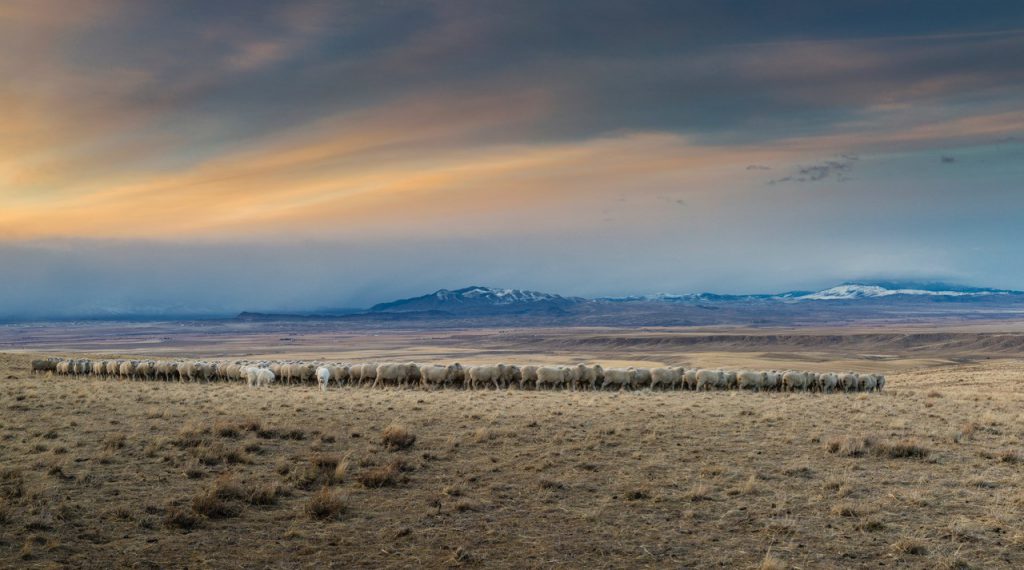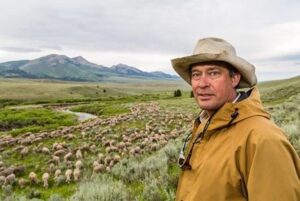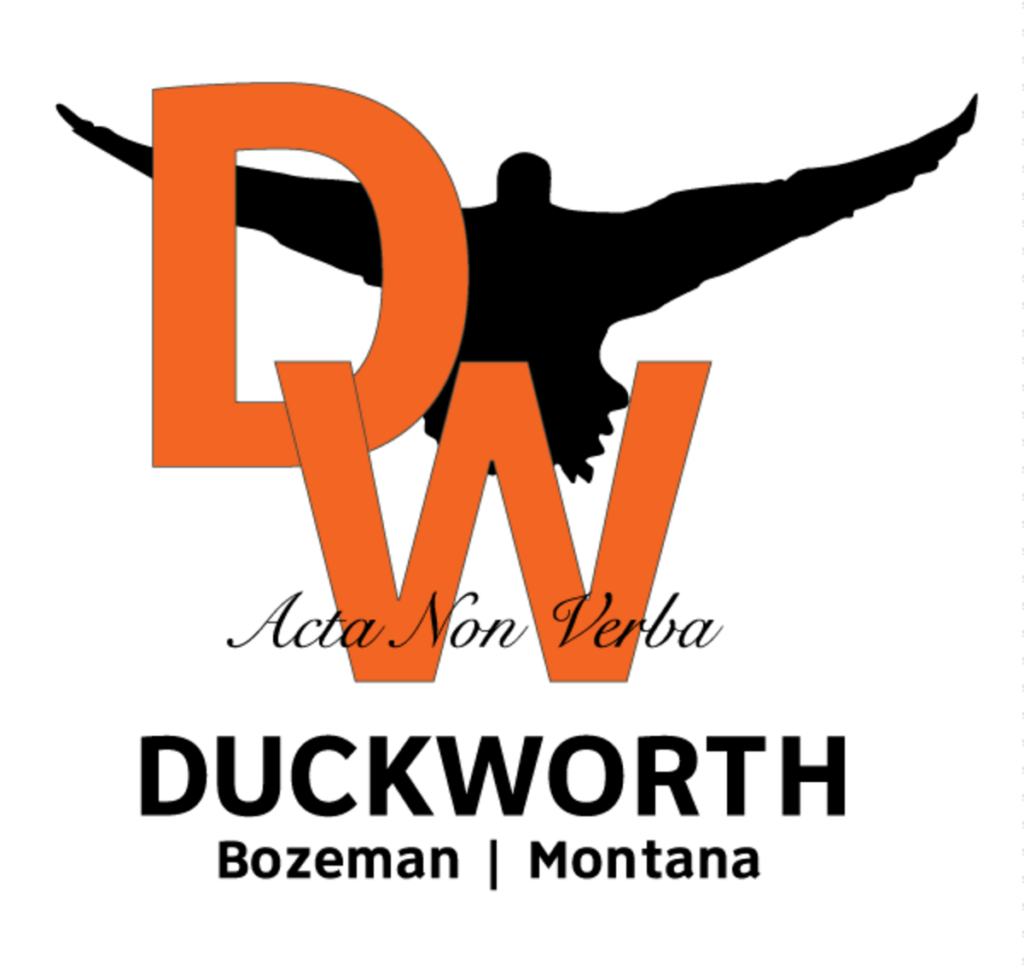
Free-roaming sheep are key to the Montana company’s success.
When searching for clothing that is manufactured in the United States, consumers often discover that many fine domestically-made garments require some portion of imported fabric.

Not so with Duckworth, a unique wool clothing company based in Bozeman, Montana.
Duckworth’s slogan is “Sheep to Shelf.”
Its clothing and fabric is 100 percent American-made, beginning with the wool from a flock of 10,000 Montana-raised sheep. The wool is sheared and sent to textile companies in North Carolina and South Carolina. There, it is spun into yarn, dyed, and knitted into fabric.
That fabric is then sent to a select group of small U.S. clothing manufacturers who cut and sew the finest wool garments found in America.
Duckworth began when Montana rancher John Helle met Robert “Bernie” Bernthal, a veteran of the outdoor industry. Bernthal had discovered that Helle possessed a rare breed of Rambouillet Merino sheep on his ranch and had an idea. Instead of just shearing the sheep’s wool for the general American wool supply chain, why not take advantage of its exquisite quality and create their own specialty clothing?
“John Helle wanted to go skiing to make sure Bernie was legit, so they spent a day on the slopes at place called Maverick Mountain, which is out by the Helle Ranch,” said company president Don Rogers. “The Helles love to ski and Bernie is [an] uber-legit skier, so they hit it off and the rest is history. A rancher and an entrepreneur, and away they went.”
The Helle family knew they were making the finest wool in the country, and were even selling the sheep’s DNA. Rambouillet Merino sheep wool is soft with long fibers, and more of a natural crimp than the typical wool that makes up America’s supply chain.
“The thing the Helle family found really disappointing is once the wool went into the bales and went to the center of the nation is… they never got to see what it turned into,” Rogers said. “There was a strong desire for them to see and know that this fine wool was being used in a great way. That’s the birth of the Sheep to Shelf concept.”
Duckworth became a company in 2013, and by the end of 2014 was producing fabric from Rambouillet Merino sheep wool. Sales began to grow in 2015 and 2016.
On Christmas Eve 2017, NBC’s Today Show ran a segment on the company. Sales skyrocketed.
Rogers, a 30-year veteran of the garment industry, joined the Duckworth team one year ago and eventually became president, replacing Bernthal, who is now the company’s chief brand officer. Even though the 50-year-old Rogers has a wealth of experience in clothing manufacturing, he was a little shell-shocked when a massive amount of orders came in after the Today Show story aired.
“My biggest concern when I kept seeing all these orders come in on Christmas Eve and Christmas Day, was I kept seeing Tennessee, North Carolina, Georgia, Florida, Washington, D.C., Baltimore and all these places we had never really sold before,” he said. “I was thinking we are going to have the highest return rate ever. Well, we had almost no returns. It was so ridiculously low, it’s that kind of awesome little surprise.
“The Southeast was not an immediate target for our growth. It was going to be an eventual target area but we sell wool, and it is hot in the South, but they love it.”
One of the reasons the Duckworth wool is so popular is because it is a comfortable fabric in either cold or hot weather. Layered garments keep the body warm in cold, winter climates, while the lightweight summertime products breath much better than cotton or polyester and dry much faster when wet.
“Wool is really a miracle fiber,” Rogers said. “Americans have this bizarre thing where we all think that wool is scratchy. In Europe, it is not even an issue. You do not have to explain wool to a European. We have a bit more education to do about the virtues of wool because people in America think it’s that terrible itchy sweater they had once upon a time. But with this fine Rambouillet Merino sheep’s wool, nothing could be further from the truth.”
With wool being such a revered fabric in Europe, it only made sense for Duckworth to begin its fabric production with the guidance of a man from England.
“We have Graham Stewart, who is a Yorkshireman from the north of England where wool is king, has always been king and will always be king,” Rogers said. “Graham is an uber-seasoned veteran in the clothing world, having always worked with wool around the world. He is a top contender for ‘I know more about wool than anyone else.’ He is a great individual to have around because from a research and development point of view it is amazing what he can pull off.
“We have this fine, fine wool and more of it than anyone else. It has all this crimp and crazy length because we are growing it above the 45th parallel and the sheep are summering in those pastures. So, we have this amazing wool, and we don’t want to make just another damn sweater or T-shirt. Having someone here like Graham, who understands wool at an absolutely elemental level, who can the help us develop new fabrics in innovative ways, is a key to our success.”

The Montana-raised sheep spend their winters on the Helle family’s 25,000-acre ranch in the Beaverhead-Deerlodge National Forest area. The herd is now completing its journey to higher elevations in the lush mountain pastures. It is believed that the divergence from cold Montana winters to summer at elevations from 6,000 to 9,000 feet helps create America’s finest wool.
When the sheep are on the move to higher elevations or when they are brought back down closer to the Helle Ranch in September, they are guided by Peruvian shepherds, Border Collies and guard dogs. This natural way of moving and caring for the animals reduces stress on the sheep, another component thought to be responsible for their unique wool growth.
The shearing of the sheep is done every spring for about five weeks, from the beginning of March through the first week of June. The sheep then make the climb to their summer home while their wool is processed under the guidance of Stewart.
“It is spun into yarn and that yarn goes into different uses,” Rogers said. “We take some of that yarn and turn it straight into our accessories like socks and our beanies. And then we take some of that yarn and go to knitters who recreate the formula that Graham has come up with to knit the different fabrics we sell. We do not do the clothing manufacturing ourselves, but the fabrics go to our cut and sew partners in North Carolina or in Chicago or in New Jersey.”
When Duckworth was launched five years ago, the goal was to keep everything American-made. The partners wanted to create American jobs and teach people how to make fabrics again.
“Most of those great textile minds from the North Carolina University system, those gentlemen are retired,” Rogers said. “We unplugged in the 1980s, so that’s a long time ago.”
He added: “We could have done this a lot easier. We could have gotten Chinese wool. We could have made up a good story and had all this stuff made in China or somewhere else around the world and it would have been a hell of a lot easier.
“But to be perfectly honest, working with an American supply chain is not always the easiest route to go. It’s not super flexible. It’s not super nimble. And we are trying to help it be those things.
“Our stuff is Made in America all the way… so we made everybody a little bit smarter along the way. It was a 100 percent conscience decision to make everything in America and bring back the American garment industry,” Rogers added. “It is just the right way to do things.”
Duckworth products, including wool jackets, T-shirts and even underwear, are sold at select outdoor retail stores and can be purchased online.
